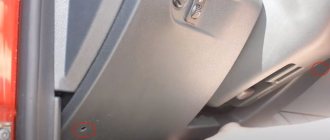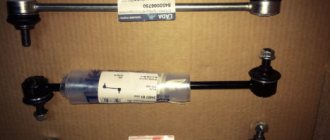Comparing Lada Vesta and Lada Largus, at first glance, will seem incorrect, due to the fact that both models occupy different niches in the market. However, they overlap in many ways. After all, many of those who were planning to purchase a Grant, Largus or Priora, after the new sedan entered the market, thought about changing their guidelines, sometimes to the detriment of their own needs. The same applies to potential owners of LADA Largus. Moreover, this decision is largely dictated by the parameters of the cars.
Which car is more prestigious
The latest trends in the field of domestic automotive fashion emphasize that Vesta is endowed with a much more advantageous appearance, and its popularity is fueled by a well-promoted advertising campaign. Against this background, Largus looks like a “dark horse”. Before the comparative review, let’s remember who was at the origins of the domestic station wagon? It can’t be, but this is Renault Logan itself and its Romanian “derivative” - Dacia Logan MCV. Such roots are worth a lot, so in the “prestige” discipline, the absolute parity of our participants should be noted.
Exterior, what is the difference between Largus and Vesta
The difference in appearance is quite noticeable, but which is better in this case, Lada Largus or Lada Vesta. Here you can safely attach the prefix “retro” to the Largus model, since against its background Vesta is positioned as a promising new product. The station wagon is endowed with calm body lines in terms of design. This is more than confirmed by the contours of the hood, head optics and front grille. If you look at the profile of this car, the viewer is visited by sadness and despondency, because the simplicity of the design is not capable of concealing zest. The station wagon's stern delivers a similar sensation. Here is a long-boring narrow bumper, the contours of which are repeated by the lines of stretched brake lights. The large glass area does not border on a sporty appearance.
If we compare, Vesta against this background is the complete opposite. The exterior design is replete with fashionable delights. The front of the car hints at speed and eccentricity, and the side panels will delight you with the modern trends of the now fashionable “X” style, which is echoed by the presence of the corresponding form of stampings. The front part is especially chic thanks to the grille, which blends smoothly with the intakes for oncoming air flow. The anti-fog optics have a distinctive style, as if emphasizing a hint of solidity. Let's continue the comparison.
Interior of Lada models
The interiors of these Lada Largus or Lada Vesta cars are also incommensurable. If Vesta’s interior will please you with its laconicism, originality and genuine attractiveness, then Largus can provide the owner with a straightforward and discreet design of most interior components. There is no need to argue about the convenience and practicality of this interior, since these qualities are at their best. It is simply devoid of bright and memorable notes.
If you compare, the interior of the Vesta features a comfortable steering rim, well-profiled seats and an elegant instrument panel, in which bright lighting instills harmony with the space.
Features of the modified Vesta
The Lada Vesta Long version received a finally formed exterior thanks to modifications to the body. The designers designed the updated car platform in such a way that, despite the increase in length, the Lada fully retained all the features of the X-shaped concept and in profile was not only longer, but also more beautiful than the production sedan. This was achieved through the use of the latest methods, which VAZ is constantly experimenting with. This is encouraging, because with the introduction of new design options, the concern is gradually raising the bar from year to year. The modified wheelbase and body length create the main effect of the transformation from a sedan to a limousine.
Dramatic changes occur due to:
- the use of a longer wheelbase in the Signature (by as much as 25 cm), after the changes it is equal to 2.86 m;
- a radical increase in body length by 25 cm (now Vesta has reached an impressive length of 4.46 m);
- moving the rear passenger seats 5 cm forward;
- visible increase in the rear door openings of the Signature;
- increasing the vertical height between the rear seats and the ceiling.
Improving the door opening is another trump card in winning over a wealthy government audience. After all, most upper-class people prefer to travel with a personal driver. Therefore, when sitting in the rear seat, the important person will feel comfortable and spacious.
Engines in Lada Vesta and Lada Largus cars
The power of the engine used in the fashionable Vesta is higher in comparison with the output of both variants of power units addressed by the manufacturer to the practical Largus station wagon. If a sedan is capable of demonstrating dynamics at the level of 11.8 seconds to the first “hundred”, and the maximum speed indicator reaches 178 km per hour, then for a station wagon these characteristics are unattainable, since its dynamics are 14.2 seconds and the speed limit is 158 km per hour. hour.
If you notice the level of fuel consumption, then the new product will also be lower. With such positive characteristics, it is difficult to decide which is better from the Lada Largus or Lada Vesta models.
Specifications
Engines
In this regard, the Lada Vesta is a complete victory. Although it has only one engine, its power is higher than that of a pair of competitor engines.
Lada Vesta boasts a 106-horsepower domestic power unit of the VAZ-21129 type. Its power is achievable at 5,800 rpm, and the peak torque of 148 Nm is at 4,200 rpm. With such characteristics, acceleration of the sedan to hundreds is achievable in 11.8 seconds. (with AMT - 12.8 seconds), while the cutoff is set at 178 km/h. Appetite is not the lowest, but quite acceptable - 8.9/5.3/6.6 liters (9.9/6.9/5.5 liters with AMT). Despite the fact that this engine has no alternative yet, it surpasses the competitor’s engines in all respects!
So far, Lada Vesta has only one 106 hp engine. s., but this is temporary!
The station wagon has two engines, but each of them is inferior to the West one. The first is a budget, 87-horsepower unit. The low power achieved at 5,100 rpm is only partly compensated by the good torque of 140 Nm at 3,800 rpm, thanks to the 1.6-liter volume. Of course, for a heavy station wagon, which also has poor aerodynamics, such an engine is frankly not enough. And the best confirmation is acceleration in 14.2 seconds, with a top speed of 158 km/h. And the consumption is quite large - 10.6/8.2/6.7 liters.
Engine Lada Largus with output of 87 hp. With. - such an engine is usually not enough for sedans, not to mention a heavy carriage.
LADA Largus also has a 1.6-liter, but already 102-horsepower engine. It is also equipped with an injector, but the increase in power also affects the speed, when its peak is reached - it has shifted to 5,750 revolutions. But the thrust almost did not increase - the increase was only 5 Nm (145 “newtons”) at 3,750 rpm. This largely determined only slightly lower gasoline consumption, which dropped to 10.1/7.9/6.7 liters. The dynamics improved by 1 second (13.1 seconds to hundreds), while the cutoff was raised to 165 km/h.
The 102-horsepower engine of the Lada Largus is noticeably more powerful and torquey than its brother.
In general, the sedan's superiority is complete - both in dynamics, and in maximum speed, and in appetite. In addition, the specified data for the station wagon does not imply its full load. But when there are 5 people in the cabin, and the things in the trunk bring the load to the maximum permissible value, the cars will begin to “drink from the tank” much more.
HR16DE / H4M - soon this engine will be derated to 110 hp. s., will also appear under the hood of the Lada Vesta.
In addition, Vesta’s meager line of engines will soon expand significantly when under the hood it will have a 122-horsepower engine from X-Ray, a 110-horsepower unit from Renault-Nissan and a budget engine with a capacity of 87 hp. s., which Lada Largus can boast of.
The appearance of a 1.8-liter engine in the LADA Vesta is only a matter of time.
Transmissions
In terms of gearboxes, LADA Vesta has an overwhelming advantage. Indeed, in addition to a pair of mechanical transmissions, it also has an AMT-type robotic gearbox. But Largus can only oppose it with a 5-speed manual transmission.
Vesta's mechanical boxes are clear and modern - both domestic and French.
MT Vestas are also 5-speed, but in terms of build quality and work they are noticeably superior to their counterparts. The sedan can be purchased with both a French transmission type JH3 510 and a Russian gearbox type VAZ-2180. And in this case it cannot be said that domestic means bad. This box from Priora was modernized, and foreign components were used in its design. For example, the Germans from Schaeffler supply switching modules for Vesta. The use of new synchronizers and an enlarged shaft leveled out noise, making the operation of the box more comfortable.
However, the manual transmission of Largus is also not bad.
But AvtoVAZ decided to abandon the “automatic” in favor of a robotic gearbox, created on the basis of “mechanics”. The concern motivated its decision by the low cost of the unit, as well as the ease of its maintenance and operation. Of course, in terms of smooth operation, this type of transmission is inferior to a classic automatic transmission with the same number of steps, but in general, driving with a “robot” is quite comfortable.
None of the competitors have a classic “machine gun”. But Lada Vesta can offer a robotic gearbox - AMT.
LADA Largus does not have any transmissions other than mechanical.
Chassis
No one expected Vesta to make revolutionary suspension solutions. That’s right - the classic design for the segment, with a torsion beam on the rear axle and MacPherson struts on the front, is used in both Vesta and Largus. At the same time, the sedan's handling is better, primarily due to a larger number of electronic systems, fine-tuning of the chassis and the absence of a heavy stern. Moreover, even a much higher ground clearance does not have an effect - Vesta takes turns more enthusiastically, reacts to steering turns more sharply, and sways less on a straight line.
The Largus chassis layout is the most standard one. However, Vesta has the same thing.
Transmission options in Lada models
We continue the comparison to understand which is better among the domestic cars LADA Largus or LADA Vesta. The Largus equipment in this part looks modest, because this model only has a five-speed manual transmission.
If we compare, for Vesta the manufacturer was not greedy and provided two “mechanics” options, as well as a progressive “AMT” robot. Let us remind you that both versions of mechanical units are reliable and have a similar arsenal of five stages. Here we see the fact that VAZ designers abandoned the classic “automatic” in favor of a “robot”. Time will tell how true this is.
Cross culture: long test drive of Lada Largus Cross
For almost two months, from mid-April to early June 2015, the second season of the “Show Russia” , in which Lada cars took a direct part - they helped us organize events, “posed” for the cameras, and most importantly, they performed a transport function, transporting from city to city of us, our things, equipment and tons of gifts for children. One of these cars was a white Largus Cross, which we received from AVTOVAZ brand new, with a mileage of 50 kilometers.
Our regular readers are familiar with this car - on May 1, 2015, we released a test drive of the Lada Largus Cross in video format . We really liked the car back then - it was roomy, designed for 7 people, with impressive ground clearance, both compared to the regular Largus and many passenger cars and other crossovers. After finishing in Togliatti, this car remained with us for a long test. It's not that we had any kind of intensive testing program - we just drove this car around the city, country roads and highways as usual. In six months we drove a little bit - right up to the first maintenance at 15,000 kilometers. But it was driven by members of the “Show Russia” team – all 6 drivers. That's why we got a lot of different impressions.
Let's sum it up
We made a comparison, and you probably decided which of the two models is better: LADA Largus or LADA Vesta. Purchasing a Largus station wagon will be a justified action only when there is an urgent need for this particular type of body, and the competitors the client likes are located very “far” outside this price segment. In all other situations, we recommend taking a closer look at the more modern, powerful, bright and original Vesta, which rightfully won the palm in our unusual comparative review.
The second test copy of the executive Lada Vesta Signature was released (photo)
31.05.2016
The price and technical characteristics of the Lada Vesta Signature, which will go into production, are not yet known
Already the second copy of Lada Vesta of the VIP category has left the AvtoVAZ workshops.
This executive class car with an extended wheelbase is called Lada Vesta Signature and is planned for release in a limited series, the price is not yet known.
However, in order for the plant management to make such a decision, the elongated Vesta must receive good ratings in tests in real conditions by those for whom it is, in fact, intended.
Officials will not just be passive passengers - over time, they are expected to provide assessments, comments and suggestions regarding the current state and ways of development of the first VAZ VIP car
Particular attention will be paid to travel comfort and quality of equipment operation.











